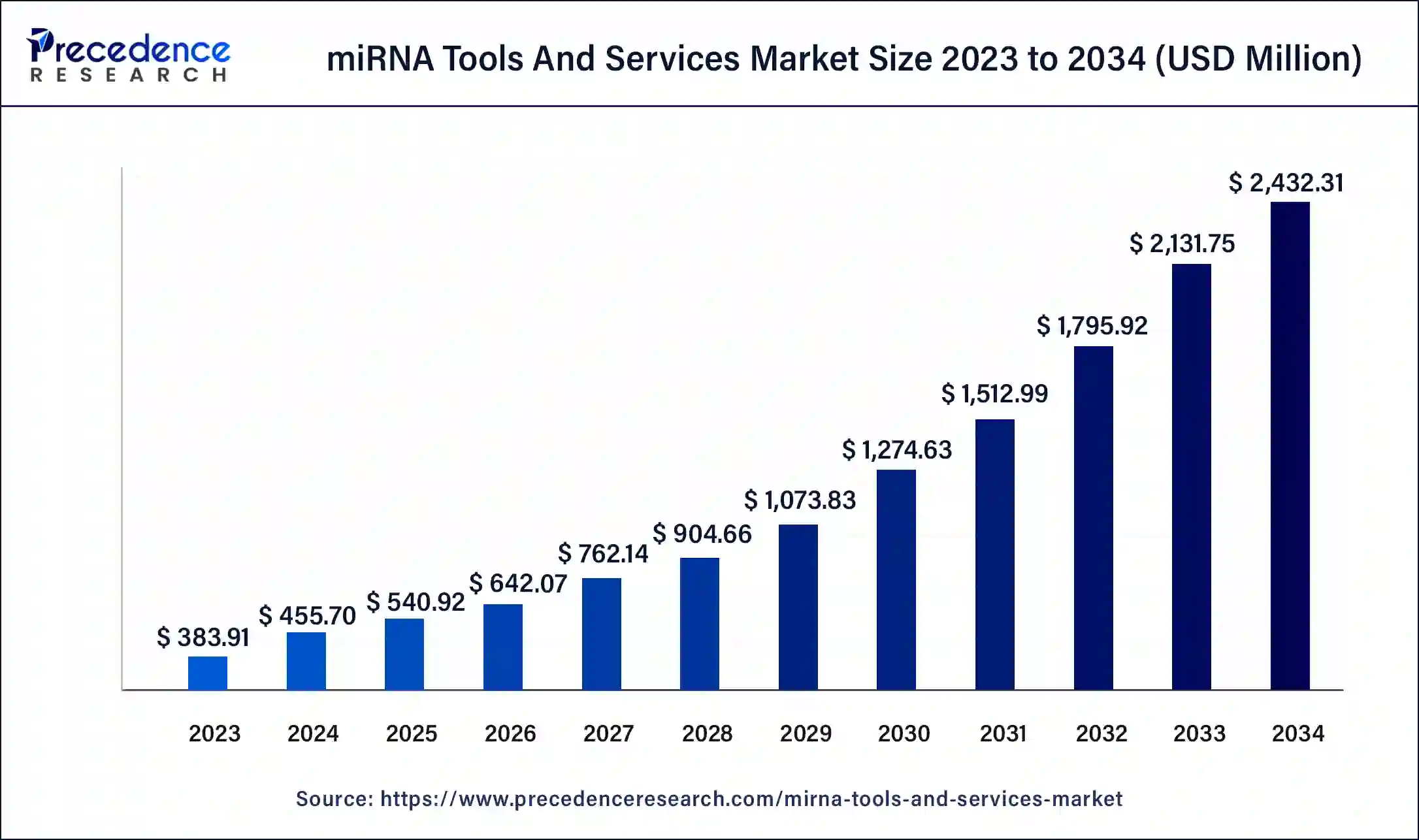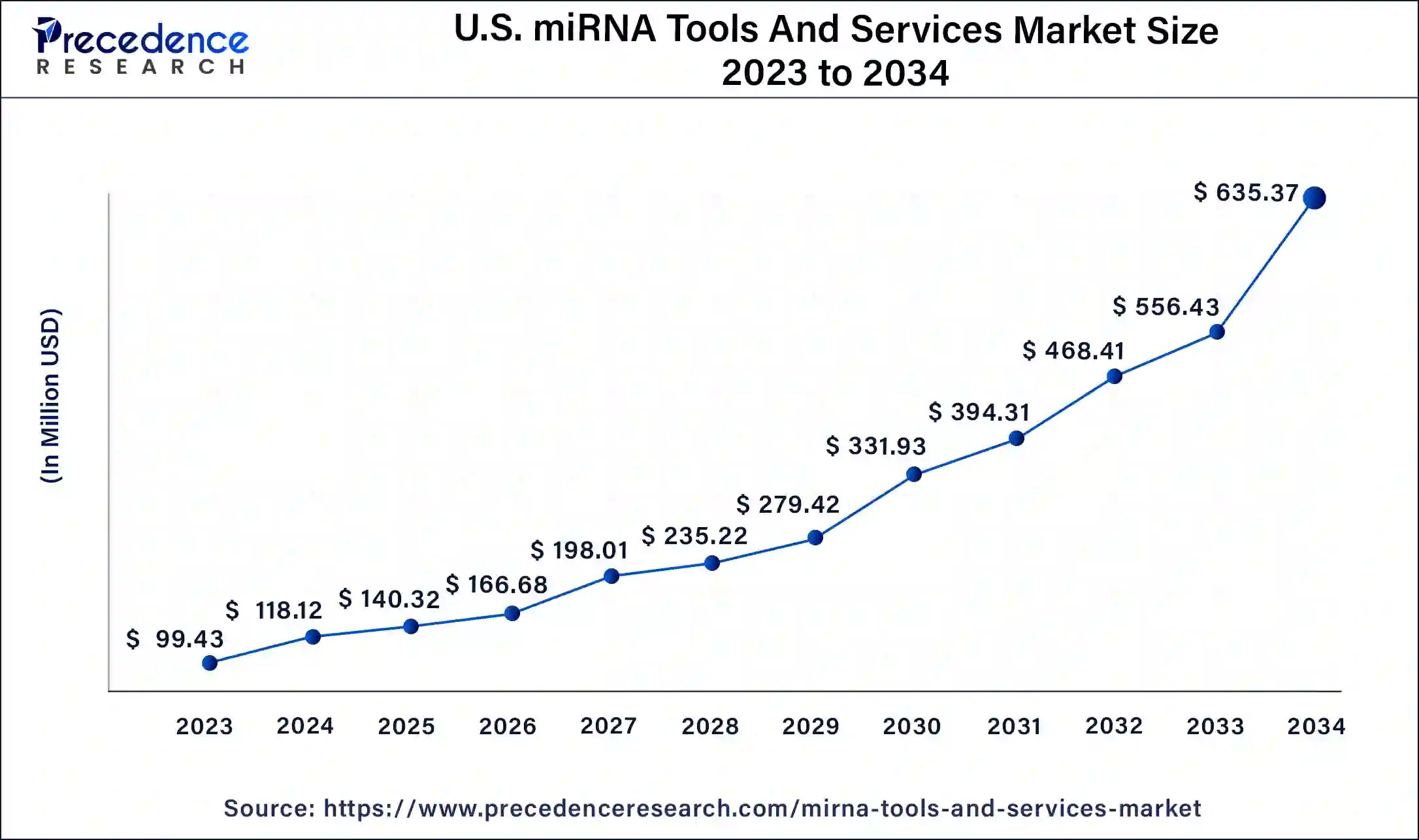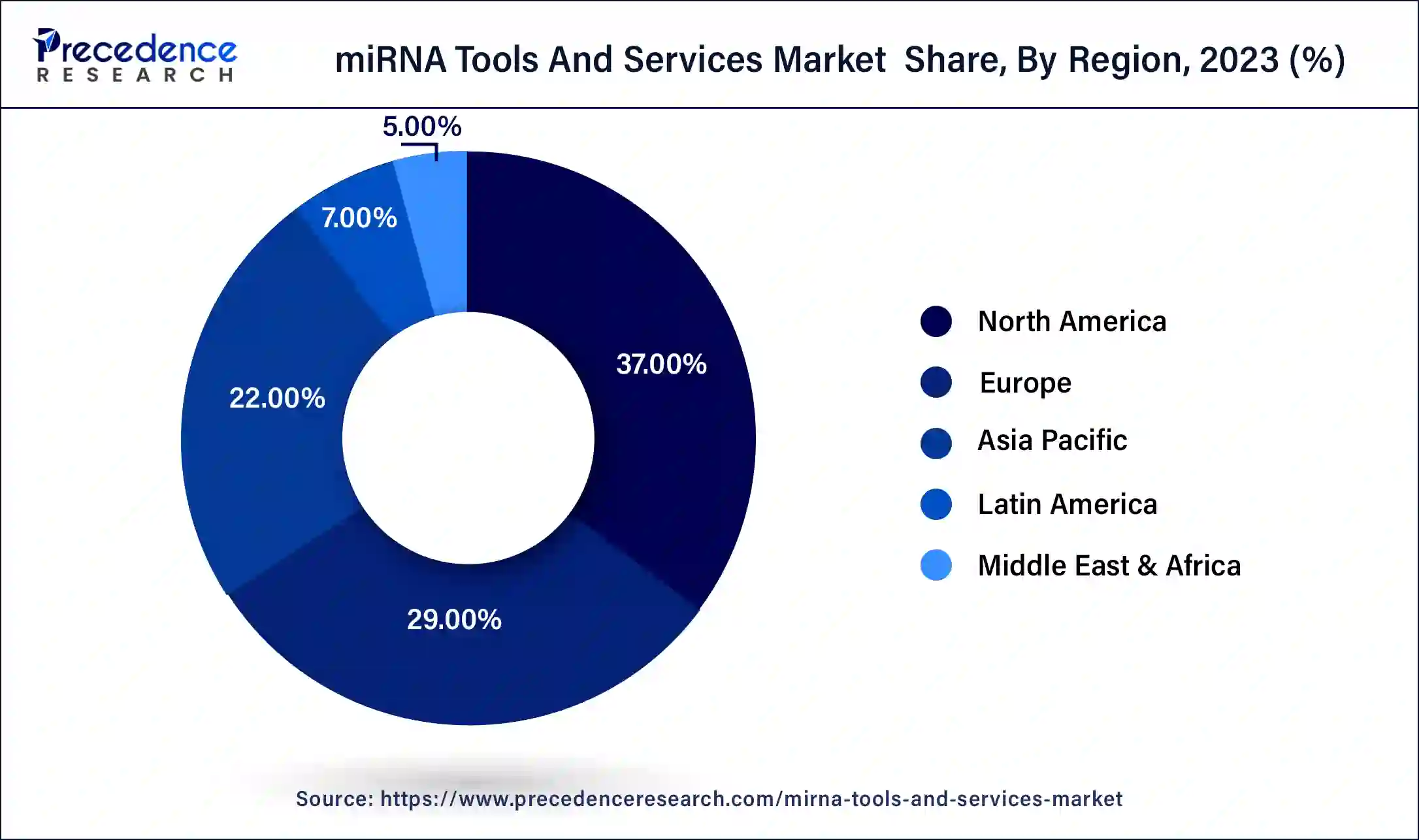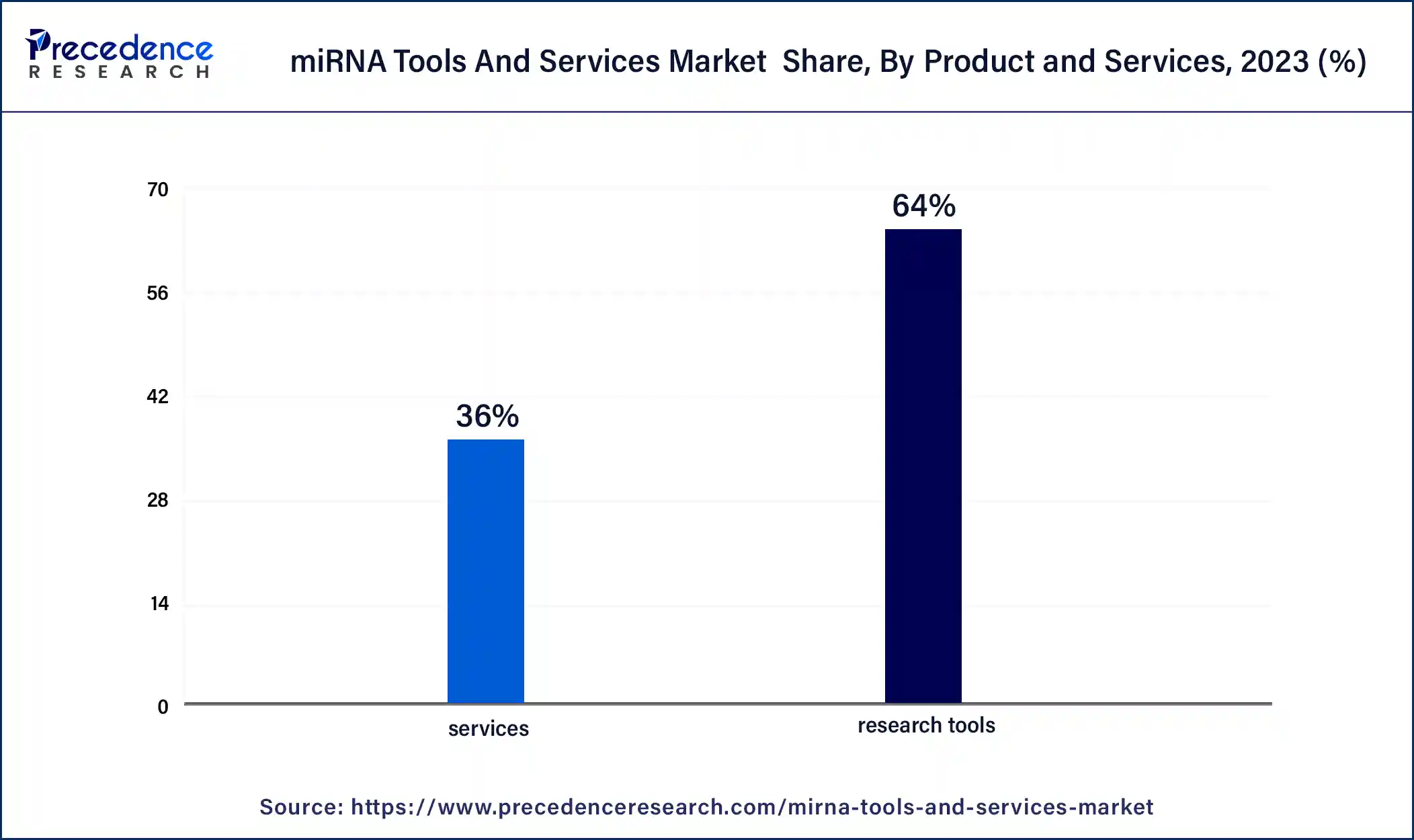June 2024
The global miRNA tools market size was USD 383.91 million in 2023, estimated at USD 455.70 million in 2024 and is anticipated to reach around USD 2432.31 million by 2034, expanding at a CAGR of 18.23% from 2024 to 2034.
The global miRNA tools market size accounted for USD 455.70 million in 2024 and is predicted to reach around USD 2432.31 million by 2034, expanding at a CAGR of 18.23% from 2024 to 2034.

AI redefines every aspect of the healthcare industry, from biomarker discovery to therapeutic development. Incorporating AI algorithms into miRNA analysis tools significantly enhances the ability to predict miRNA activity. This predictive capability provides researchers with deeper insights into functions and potential interactions of miRNAs within cellular contexts. Moreover, AI can analyze large datasets generated from miRNA studies, leading to precise interpretations of miRNA functions. AI can analyze expression profiles, which helps in the identification of novel miRNA biomarkers.
The U.S. miRNA tools and services market size was valued at USD 99.43 million in 2023 and is expected to reach USD 635.37 million by 2034, growing at a CAGR of 18.32% from 2024 to 2034.

North America held the largest revenue share 37% in 2023. North America holds a major share in the miRNA tools and services market due to its robust research infrastructure, substantial investments in genomics, and a high prevalence of collaborations between research institutions and biotechnology companies. The region's emphasis on precision medicine and strong support from government initiatives contribute to the market's growth. Additionally, the presence of key industry players and a proactive approach toward adopting advanced technologies further solidify North America's dominance in the miRNA tools and services sector.

Asia-Pacific is estimated to witness the highest growth. Asia-Pacific dominates the miRNA tools and services market due to a thriving biotechnology and pharmaceutical sector, along with rising investments in genomics research. The region's large patient population facilitates extensive biomarker discovery and clinical research, driving demand for miRNA tools. Additionally, a supportive regulatory environment and increasing collaborations between research institutions and industry players contribute to market growth. The focus on precision medicine initiatives and the adoption of advanced technologies in countries like China, Japan, and India further solidify Asia-Pacific's significant share in the miRNA tools and services market.
miRNA tools and services refer to a suite of resources and services dedicated to the exploration of microRNAs, tiny molecules with big roles in regulating genes. These tools consist of bioinformatics software and databases, empowering researchers to predict and analyze miRNA target genes, and unraveling their functions in various biological processes.
In addition to bioinformatics resources, miRNA services also encompass experimental techniques for miRNA profiling, quantification, and functional studies. These services may include next-generation sequencing for miRNA expression profiling, qRT-PCR assays for quantitative analysis, and functional assays to investigate the impact of miRNAs on specific cellular pathways. miRNA tools and services collectively contribute to advancing our understanding of gene regulation and its implications in health and disease, providing researchers with valuable resources for both computational analysis and experimental validation of miRNA-related phenomena.
| Report Coverage | Details |
| Market Size by 2034 | USD 2432.31 Million |
| Market Size in 2023 | USD 383.91 Million |
| Market Size in 2024 | USD 455.70 Million |
| Growth Rate from 2024 to 2034 | CAGR of 18.23% |
| Largest Market | North America |
| Base Year | 2023 |
| Forecast Period | 2024 to 2034 |
| Segments Covered | By Product and Services, By Technology, and By End User |
| Regions Covered | North America, Europe, Asia-Pacific, Latin America, and Middle East & Africa |
Technological Advancements
The emergence of single-cell technologies has revolutionized the study of miRNA expression by allowing scientists to examine miRNA activity at an unprecedented resolution. This capability opens up exciting new avenues for exploring the cellular heterogeneity within tissues, enabling a more nuanced understanding of how different cell types utilize miRNAs. Integrating CRISPR/Cas9 technology into miRNA research represents a significant leap forward in conducting precise genome editing. This precision enables researchers to pinpoint and manipulate specific miRNAs, more accurately exploring their roles and functions within the genome. This approach facilitates the exploration of miRNA effects on gene regulation and allows for the dissection of pathways involved in various cellular processes.
Ongoing advancements in functional genomics technologies are vital for understanding how miRNAs influence gene expression and orchestrate complex cellular processes. By leveraging these innovative tools and methodologies, researchers are better equipped to unravel the intricate gene regulation networks governed by miRNAs.
Limited standardization and complex data analysis
Limited standardization and the complexity of data analysis act as significant restraints on the market demand for miRNA tools and services. The absence of standardized protocols and methodologies across these tools introduces challenges in achieving consistency and comparability in research outcomes. Researchers face difficulties in harmonizing results from different platforms, hindering the broader adoption of miRNA tools. Complex data analysis is a significant hurdle, given the intricate nature of miRNA regulatory networks and the large datasets involved.
This complexity not only complicates the accurate interpretation of data but also makes it challenging for researchers to effectively use the results. These obstacles limit the accessibility of miRNA tools, especially for researchers with varying levels of computational skills, hampering the seamless integration of miRNA research into broader genomics and precision medicine endeavors.
Integration with multi-omics approaches and expansion in clinical applications
The integration of miRNA tools with multi-omics approaches presents a promising opportunity in the miRNA tools and services market. Aligning miRNA data with other omics layers, such as transcriptomics and proteomics, offers a holistic perspective on molecular interactions. This integration enhances the capability to decipher complex biological networks, providing researchers with a more comprehensive understanding of the functional implications of miRNA expression patterns. The synergy of multi-omics approaches creates a demand for advanced tools that facilitate seamless data integration, enabling researchers to explore the synergies and interactions between different molecular layers.
Furthermore, the expansion of miRNA tools into clinical applications is a significant avenue for growth. The increasing recognition of miRNAs as potential biomarkers for various diseases fuels demand for tools tailored to clinical settings. Opportunities lie in the development of user-friendly, clinically validated miRNA tools that can be seamlessly integrated into diagnostic and prognostic workflows. As miRNAs gain prominence in precision medicine, tools facilitating their efficient translation from research settings to clinical applications are essential, contributing to the overall expansion of the miRNA tools and services market.
In 2023, the research tools segment held the highest market share of 64% based on the product and services. In the miRNA tools and services market, the research tools segment encompasses a suite of bioinformatics software, databases, and experimental technologies designed for the identification, profiling, and functional analysis of microRNAs. This segment includes tools for predicting miRNA targets, exploring regulatory networks, and conducting experimental validation studies. Trends in this segment focus on the integration of artificial intelligence for enhanced data analysis, the development of user-friendly platforms, and the continual refinement of next generation sequencing technologies, reflecting a dynamic landscape that empowers researchers in unraveling the complexities of miRNA biology.

The services segment is anticipated to witness the highest growth at a significant CAGR of 19.5% during the projected period. In the miRNA tools and services market, the services segment encompasses a range of offerings supporting researchers in miRNA-related studies. These services include miRNA profiling, quantification, and functional analysis. Trend-wise, there is a growing demand for customized miRNA profiling services tailored to specific research needs.
Additionally, as the clinical application of miRNAs gains momentum, services facilitating the translation of miRNA discoveries into diagnostic and therapeutic insights are becoming increasingly prominent, reflecting a trend toward more comprehensive and application-oriented offerings in the miRNA services landscape.
According to the technology, the qRT-PCR segment will held a 25% revenue share in 2023. qRT-PCR, or quantitative reverse transcription polymerase chain reaction, is a key technology in the miRNA tools and services market. It enables precise quantification of miRNA expression levels, providing crucial insights into gene regulation. The qRT-PCR segment is witnessing a trend towards increased sensitivity and specificity, allowing researchers to detect low-abundance miRNAs accurately. Furthermore, the development of streamlined and high-throughput qRT-PCR platforms enhances efficiency, making this technology pivotal in miRNA research for both basic understanding and clinical applications.
The microarray segment is anticipated to witness the highest growth over the projected period. In the miRNA tools and services market, the microarray segment involves the use of microarray technology to profile and analyze miRNA expression patterns. Microarrays allow simultaneous detection of multiple miRNAs, enabling efficient high-throughput analysis.
A trend in this segment is the continuous refinement of microarray platforms, enhancing sensitivity and specificity. Advancements include improved probe design, increased array density, and the incorporation of novel detection methods. These trends contribute to the evolving landscape of miRNA analysis, providing researchers with enhanced tools for comprehensive exploration of miRNA regulatory networks.
According to the end user, the research and academic institutes segment held a 34% revenue share in 2023. The research and academic institutes segment in the miRNA tools and services market comprises universities, research centers, and academic laboratories engaged in genomic studies. Trends in this segment involve a growing emphasis on miRNA research for understanding gene regulation. Academic institutes increasingly integrate miRNA tools to explore biological processes, contributing to advancements in genomics. The demand for user-friendly tools and collaborative initiatives among academic institutions for sharing miRNA datasets are notable trends, fostering a dynamic landscape within the research and academic institutes segment of the miRNA tools and services market.
The CROs segment is anticipated to witness the highest growth over the projected period. Contract Research Organizations (CROs) in the miRNA tools and services market refer to third-party entities providing research and development services to pharmaceutical, biotechnology, and academic institutions. CROs play a pivotal role in miRNA research, offering expertise and specialized tools for profiling, validation, and data analysis. A notable trend in this segment involves increased outsourcing of miRNA-related projects by pharmaceutical companies and research institutions to CROs, driven by the need for cost-effective solutions, access to specialized knowledge, and accelerated project timelines.
Segments Covered in the Report
By Product and Services
By Technology
By End User
By Geography
For inquiries regarding discounts, bulk purchases, or customization requests, please contact us at sales@precedenceresearch.com
No cookie-cutter, only authentic analysis – take the 1st step to become a Precedence Research client
June 2024
April 2025
December 2024
January 2025